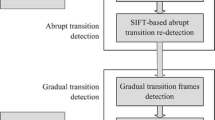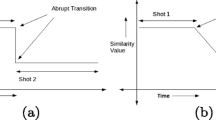Abstract
In this paper, an accumulation algorithm for video shot detection is introduced. The algorithm considers the properties of gradual transition. In a gradual transition, there is only a small difference between consecutive frames. The algorithm remembers the differences between consecutive frames and accumulates them. When the accumulation difference exceeds a threshold, an occurrence of shot transition is declared. Our main contributions are to introduce a frame C that remembers the changes from the beginning of a shot and detect the different types of boundaries (cut, fade, dissolve) at one process. We tested our algorithm with clips extracted from MPEG VCDs. The algorithm showed a good performance in detecting the gradual transitions as well as the abrupt cuts and has the ability to identify different types of boundaries.
Similar content being viewed by others
References
F. Arman, A. Hsu, and M.Y. Chiu, “Image processing on compressed data for large video database,” in Proceedings of First ACM International Conference on Multimedia, 1993, pp. 267–272.
R.M. Ford, C. Robson, D. Temple, and M. Gerlach, “Metrics for shot boundary detection in digital video sequences,” Multimedia Systems, Vol. 8,No. 1, pp. 37–46, 2000.
U. Gargi, R. Kasturi, and S.H. Strayer, “Performance characterization of video-shot-change detection methods,” IEEE Transactions on Circuits and Systems for Video Technology, Vol. 10,No. 1, pp. 1–13, 2000.
Y. Gong, “An accurate and robust method for detecting video shot boundaries,” Multimedia Computing and Systems, IEEE International Conference, Vol. 1, pp. 850–854, 1999.
A. Hampapur, E.T. Weymouth, and R. Jain, “Digital video segmentation,” in Proceedings of ACM Multimedia 94 (San Francisco), 1994, pp. 357–364.
A. Hanjalic, M. Ceccarelli, R.L. Lagendijk, and J. Biemond, “Automation of systems enabling search on stored video data,” in Proceedings of IS&T/SPIE Storage and Retrieval for Image and Video Databases V, 1997, Vol. 3022.
R. Jain, R. Kasturi, and B.G. Schunk, Machine Vision, McGraw-Hill: New York, 1995, pp. 406–415.
G. Lupatini, C. Saraceno, and R. Leonardi, “Scene break detection: A comparison,” Research Issues In Data Engineering, ‘Continuous-Media Databases and Applications,’ in Proceedings of Eighth International Workgroup, 1998, pp. 34–41.
J. Meng, Y. Juan, and S. Chang, “Scene change detection in mpeg compressed video sequence,” in Proceedings of SPIE: Digital Video Compression: Algorithms and Technologies, 1995, Vol. 2419.
A. Nagasaka and Y. Tanaka, “Automatic video indexing and full-video search for object appearances,” Visual Database Systems II, pp. 113–127, 1992.
Y. Nakajima, “Video browsing using fast scene cut detection for an efficient networked video database access,” IEICE Transactions on Information and Systems, Vol. E77-D,No. 9, pp. 1355–1364, 1994.
S.C Pei and Z. Yu, “Efficient MPEG compressed video analysis using macro block type information,” IEEE Transactions on Multimedia, Vol. 1,No. 4, pp. 321–333, 1999.
Y. Rui, T.S. Huang, and S. Mehrotra, “Constructing table-of-content for videos,” ACM Multimedia Systems Journal, Special Issue Multimedia Systems on Video Libraries, Vol. 7,No. 5, pp. 359–368, 1999.
I.K. Sethi and N. Patel, “A statistical approach to scene change detection,” in Proceeding of SPIE (Storage and Retrieval for Image and Video Databases III) 2420, 1995, pp. 329–338.
B. Shahraray, “Scene change detection and content-based sampling of video sequences,” in Digital Video Compression: Algorithms and Technologies, 1995, pp. 2–13.
M.A. Smith and T. Kanade, “Video skimming and characterization through the combination of image and language understanginf techniques,” in Proceedings of CVPR'98 (PuertoTico), 1998, pp. 775–881.
S.W. Smoliar and H. Zhang, “Content-based video indexing and retrieval,” IEEE Multimedia, Vol. 1,No. 2, pp. 62–72, 1994.
H. Ueda, T. Miyatake, and S. Yoshizawa, “Impact: An interactive natural-motion-picture dedicated multimedia authoring system,” in Proceedings of CHI (New Orleans), 1991.
B.L. Yeo and B. Liu, “Rapid scene analysis on compressed video,” IEEE Transactions on Circuits and Systems for Video Technology, Vol. 5,No. 6, 1995.
R. Zabhi, J. Miller, and K. Mai, “A feature based algorithm for detecting and classifying scene breaks,” in Proceedings of ACM Multimedia, 1995, pp. 198–200.
H. Zhang, A. Kankanhalli, and S.W. Smoliar, “Automatic partitioning of full-motion video,” Multimedia Systems on ACM, Vol. 1,No. 1, pp.10–28, 1993.
H. Zhang, A. Kankanhalli, and S.W. Smoliar, “Video parsing and browsing using compressed data,” Multimedia Tools and Applications, Vol. 1.1, pp. 89–111, 1995.
D. Zhong and S.F. Chang, “An integrated approach for content-based video object segmentation and retrieval,” IEEE Transactions on Circuits and Systems for Video Technology, Vol. 9,No. 8, 1999.
Author information
Authors and Affiliations
Rights and permissions
About this article
Cite this article
Lu, T., Suganthan, P. An Accumulation Algorithm for Video Shot Boundary Detection. Multimedia Tools and Applications 22, 89–106 (2004). https://doi.org/10.1023/B:MTAP.0000008661.37331.c7
Issue Date:
DOI: https://doi.org/10.1023/B:MTAP.0000008661.37331.c7




